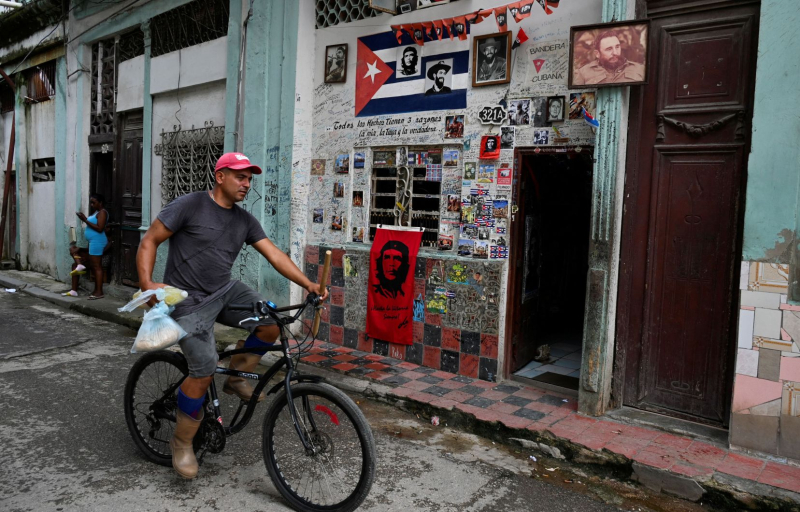
Photo: Yamil Lage Agence France-Presse A man rides a bicycle past posters of Fidel Castro and Ernesto “Che” Guevara on a street in Havana, October 22, 2024.
Jordane Bertrand – Agence France-Presse in Havana
Published at 1:35 p.m. Updated at 8:28 p.m.
- Americas
Electricity service continued to be restored in Cuba on Tuesday, with more than 70 percent of the population now powered four days after a massive blackout, worsened by Hurricane Oscar that killed seven people, according to a new report.
The island of 10 million inhabitants has been experiencing an exceptional situation since Friday with a general power outage and the passage of Hurricane Oscar, a category 1 hurricane, which swept through the eastern part of the island on Sunday and Monday.
On Tuesday, Cuban President Miguel Diaz-Canel indicated on X that the death toll from the hurricane was now seven in the province of Guantanamo (east), one more than previously.
Six people died in San Antonio del Sur and “we learned of the loss of another person in Imias”, a neighboring town, the head of state said.
In both cities, flooding “at levels never recorded in history” occurred, “with more than 366 millimeters of rainfall recorded in 24 hours, according to the authorities. Roofs were blown away, houses destroyed, power poles and trees fell.”
Hurricane Oscar, which made landfall on Sunday evening with winds approaching 130 km/h, before being downgraded to a tropical storm, finally moved away from Cuban territory on Monday evening and the authorities lifted the alert on Tuesday.
200% Deposit Bonus up to €3,000 180% First Deposit Bonus up to $20,000Meanwhile, the restoration of power continues on the island. “This morning [Tuesday], 70.89% of customers in Cuba are receiving electricity service,” the Ministry of Energy and Mines reported on its X account.
For now, according to authorities, the eastern provinces of Guantanamo and Santiago de Cuba are the provinces where electricity availability remains lowest. In the west of the island, where Havana is located, the restoration of service has reached 95%, while it is between 40 and 60% in the center of the country.
On Friday, a breakdown at the country's main thermoelectric plant, located in the western province of Matanzas, caused the total collapse of the network. Since then, authorities have been working to restore electricity service to the population.
Since Monday evening, Havana's two million residents have had power again and the capital has resumed a good part of its activities, AFP has noted.
“We can only be happy. It was about time! I had been sleeping badly for days, without a fan,” Magalis Manzano, 81, a resident of the Old Havana neighborhood, rejoiced to AFP.
Planned power cuts, already in place before the outage to deal with the energy crisis that is shaking the country, have however resumed on Tuesday in the capital.
Read also
- In Cuba, where anger is growing against shortages, the government denounces destabilization
- In Cuba, the latest SUVs and 4x4s steal the spotlight from old American cars
« 28 demonstrations”
Faced with the persistence of the energy crisis, the Cuban president warned on Sunday that his government would not tolerate disturbances to public order, while residents took to the streets on Saturday and Sunday evening to demonstrate their exasperation.
Power outages were one of the triggers for the historic July 11, 2021 protests, and other protests since then.
“We have recorded at least 28 protests in the country in recent days, since the collapse of the national electricity system on October 18,” said the off-island human rights NGO 11J.
Cuba is facing its worst economic crisis in thirty years. The massive blackout, which follows chronic blackouts, is compounded by shortages of food, medicine and soaring inflation.
On Thursday, the day before the blackout, Cuba's president announced that the island was in an “energy emergency” due to difficulties in purchasing the fuel needed to power its power plants, due to the tightening of the embargo imposed by Washington since 1962.
In Cuba, electricity is produced by eight old thermoelectric power plants, often broken down or undergoing maintenance, as well as by several floating power plants rented from Turkish companies, and by generators. The use of renewable energy is in its infancy.
In September 2022, the island had already experienced a general blackout after Hurricane Ian which hit the west of the island.

